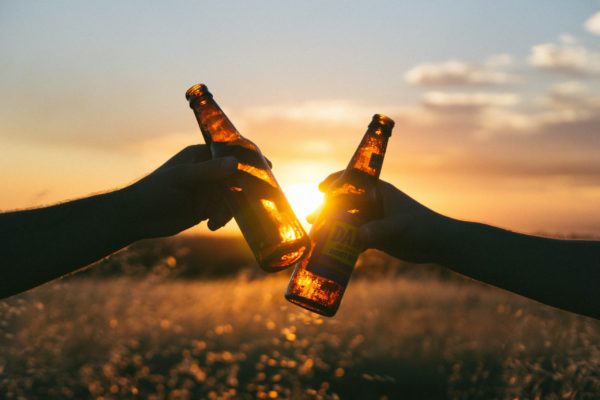You may think of yourself as a beer super-fan, but have you ever thought about the origins of your favorite beverage? Beer has been around for a lot longer than you probably think—we’re talking before the Middle Ages, right when civilization started. If you’ve ever been curious about who invented beer and when stay tuned.
When was beer invented?
It’s difficult to pin down exactly when beer was invented since it’s been around for such a long time. The world’s first fermented beverages probably emerged with the development of cereal agriculture around 12,000 years ago. During this time, hunter-gatherer tribes settled into civilizations based on crops like wheat, rice, barley, and corn. Some anthropologists theorize that they also stumbled upon fermentation and started brewing beer. Still, there isn’t enough evidence to confirm this concretely.
The earliest confirmed alcoholic beverage is a 9,000-year-old Chinese concoction made from rice, honey, and fruit. The first barley beer was probably born in the Middle East, somewhere near modern-day Iraq, and hard evidence of beer production dates back around 5,000 years in ancient Mesopotamia. However, people were most likely brewing beer long before this point.
Beer and ancient civilizations
The first concrete evidence of beer attributes the invention to the Sumerians of Mesopotamia. Archaeologists have discovered ceramic vessels from 3400 B.C. containing sticky beer residue. The song “Hymn to Ninkasi” was written down on a clay tablet around 1800 B.C. Ninkasi was the Sumerian goddess of beer, and the song describes a recipe for an ancient beer made by a female priestess. Beer was a cornerstone of the Sumerian diet, and the ancient civilization was likely brewing multiple different styles of beer.
Ancient Sumerians weren’t the only civilization with a taste for beer. Babylonians had around 20 recipes for beer. Egyptian Pharaohs were buried with vats of it. The workers who built the pyramids in Ancient Egypt were even paid in it. Beer likely traveled from there to Ancient Greece and Rome, where it did exist, although it was never as popular as wine. Beer lovers have been around since the invention of the beer itself.
Aside from the flavor of beer and the fact it got them drunk, ancient civilizations loved beer because it was one of the safest beverages available. Water in ancient civilizations wasn’t always potable, so alcoholic drinks like beer, which were naturally preserved and sanitized by heat, were safest.
Beer’s evolution throughout history
Beer wasn’t always the hoppy, bubbly, amber-colored beverage we know today. Ancient civilizations used to add things to their beer that would be considered pretty nasty by today’s standards; things like olive oil, bog myrtle, cheese, meadowsweet, mugwort, carrot, and even hallucinogens like hemp and poppy. Babylonian beer was usually drunk with a straw, as it was so thick and full of grain.
In the Middle Ages, one of the places you’d find beer most frequently was, believe it or not, monasteries. Monks created breweries as places for travelers to stop, rest, and grab a drink and a bite to eat.
Beer, as we know it today, arrived by the 16th century. Germany put a beer purity law into a practice called “Reinheitsgebot.” This law listed only water, hops, and yeast as acceptable brewing ingredients, eliminating all the extras other cultures added throughout history. Yeast, however, was not included and is fairly essential to beer production. Yeast was added back onto the acceptable ingredients list a few centuries later.
Today, it’s difficult to imagine a beer without hops of any kind, but they weren’t always included in ancient beer recipes. Ancient Egyptians stabilized and flavored their beer with ingredients like wild herbs, dates, olive oil, and meadowsweet. Early brewers in Europe had to rely on a mixture of herbs and spices called gruit. Hops only began to regularly find their way into beer around 1000 A.D., and Germany began exporting hops for brewing around the 13th century.
Beer in the United States
Throughout American history, beer has been through ups and downs. Today, beer is more popular than ever, largely driven by the craft beer movement. However, it hasn’t always been this way.
The early days of beer in the United States
The first brewery in the United States was set up in New Amsterdam, which is modern-day New York City, in 1632. It was opened by the Dutch West India Company on the aptly named Brewer St. Commercial brewing wasn’t common at the time, as most people just brewed their own individual beer at home. This first brewery was built so that settlers in New Amsterdam could focus on developing the land and not worry about making their own beer.
Breweries began opening up across the US as settlers moved further west. As populations grew, more breweries popped up. In new settlements, breweries served multiple functions. Homebrewing was fairly dangerous at the time, and many fires occurred while trying to boil ingredients. Commercial breweries were much safer.
Additionally, building a brewery brought an economic boost to the area. In many settlements, a brewery or tavern was the first structure built. This was to encourage people to stop in the area. Commercial breweries played a big role in the growth of colonies beyond the East Coast.
Unfortunately, commercial breweries were difficult businesses to run. Beer was seen as a lighter alternative to hard liquors, as most beers brewed during this period were no more than 3-4% ABV. In fact, women and children would often drink “small beers,” a very lightly alcoholic beverage made from leftover beer, usually around 1% ABV.
If Colonists wanted higher quality beers, they typically had to be imported from England. However, as the Revolutionary War loomed, imported beers became harder to come by. The war actually pushed Americans to brew a higher-quality beer so they wouldn’t be dependent on the British. In fact, many of the founding fathers started their own breweries or were involved in the beer ingredients supply chain.
The beer revival of the late 1800s
After the war, beer culture in the U.S. stayed relatively stagnant until around 1879. St. Louis became a hub for German immigrants, and these immigrants brought an explosion of beers, mostly lagers.
Dozens of new breweries popped up in St. Louis, including a small operation by Eberhard Anheuser. Eventually, Anheuser’s son-in-law, Adolphus Busch, joined the operation, and the two used technology to expand their business. The Anheuser-Busch purchased refrigerated train cars to help transport their product and employed pasteurization to ship their product coast to coast. Anheuser-Busch became the first national commercial brewery and changed the way beer was distributed forever.
Who invented the most popular beers?
Have you ever wondered who invented your favorite brew? We’ve compiled a list of all your favorite beers and their inventors, so you’ll know who to toast to the next time you crack open a can or bottle.
Budweiser
Budweiser is an incredibly popular American-style lager. It was invented by the Anheuser-Busch company in the mid-1800s. Anheuser-Busch changed the game for beer in America and brought about innovations like refrigerated train cars and pasteurizations. They became the first national brewery in America and introduced America to our beloved lagers.
Guinness
Guinness, a dry Irish stout, was invented by Arthur Guinness. Guinness opened up his brewery in 1752 but didn’t perfect his favorite black beer recipe until around 1799. This is the beer that would become Guinness. In 1803, Arthur’s son, Arthur II, took over the business and helped spread the beer across the globe.
Blue Moon
Blue Moon, a Belgian-style White Wheat beer, began with the vision of a man named Keith Villa. Villa created the recipe after studying beer-making in Brussels. He loved Belgian white beers and decided to make this the basis of his creation. Keith decided to add a citrus peel and coriander to his brew, and this, the fruity Blue Moon we know and love today, was born.
Coors
If your favorite beer is Coors Light, Coors Banquet, or Coors Original Classic American Lager, you owe your thanks to a German immigrant named Adolph Coors. Coors moved to the U.S. and opened a brewery and opened a brewery in Colorado in 1873. The Coors company was the first to use an entirely aluminum can and started the trend all the way back in 1959.
Corona
Corona, the most popular imported beer in the United States, is a Mexican beer, but its recipe actually has German origins. It’s a pilsner beer first developed in 1925 by Grupo Modelo, the largest brewery in Mexico. Grupo Modelo was founded by Antonino Fernández Rodríguez, so if you love Corona, you owe him a thank you.
The takeaway
If you’re a beer lover, you may have wondered who invented your favorite beverage. Beer has been around for centuries, so it’s difficult to attribute the invention to just one person. We know that beer has been enjoyed since ancient times and has influenced culture in major ways throughout history.
If you want to enjoy your favorite brews tonight without having to get off the couch, Saucey has your back. Order today and let Saucey handle the rest.




